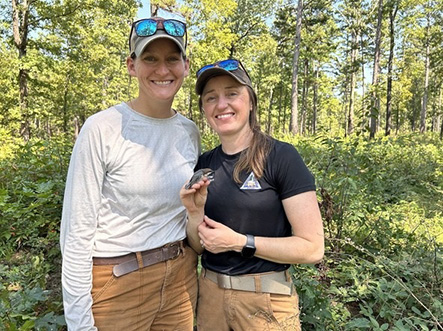JEFFERSON CITY, Mo. – The Missouri Department of Conservation (MDC) and partners recently finished phase three of Brown-headed Nuthatch reintroduction efforts in the Missouri Ozarks. In 2020 and 2021, MDC released 102 birds to the U.S. Forest Service’s Mark Twain National Forest as part of a pilot effort to achieve holistic ecosystem restoration of Missouri’s shortleaf pine woodlands. To continue this effort and to establish an extensive, sustainable population, 95 more nuthatches were reintroduced Aug. 27-30.

MDC and partners recently wrapped up round three of Brown-headed Nuthatch reintroduction efforts in the Missouri Ozarks. Pictured is U.S. Fish and Wildlife Service Migratory Bird Biologist Sarah Kendrick (left) with Missouri State Ornithologist Kristen Heath-Acre.
Brown-headed Nuthatches are only found in pine-woodlands where the pines are mature, the canopy is mostly open to sunlight, and there are plenty of well-decayed snags for nesting. Brown-headed Nuthatches were likely extirpated from Missouri in the early 1900s when the last large swaths of shortleaf pine woodlands were removed by intensive harvest and logging. The Ozark landscape regrew into primarily oak-hickory forest, which is unsuitable for Brown-headed Nuthatches. However, decades of pine woodland restoration by the Mark Twain National Forest has returned Brown-headed Nuthatch habitat to the landscape.
“Brown-headed Nuthatches excavate their own cavities, and so they employ an important role in the ecosystem,” explained MDC State Ornithologist Kristen Heath-Acre. “The cavities they create are used by other bird species, as well as mammals such as flying squirrels.”
A portion of the birds were fitted with a tiny radio transmitter and are being monitored using a local array of automated telemetry Motus towers.
“We’re monitoring their movements and survival like this, in combination with tracking them on foot, to get a clearer picture of their space-use and dispersal behavior after release,” said Heath-Acre. “This will help us identify habitat management that best suits these birds because what’s good for Brown-headed Nuthatches is good for Missouri’s pine woodland ecosystem as a whole. These birds are teaching us a lot about how far we’ve come in terms of habitat restoration over the past three decades and are helping lead a path forward.”
Partnerships were key in making this conservation action possible, involving nearly a dozen state, federal, and non-government organizations which came together to capture, translocate, and release Brown-headed Nuthatches. Partners include U.S. Forest Service’s Mark Twain National Forest, Ouachita National Forest and Northern Research Station, the University of Missouri, Central Hardwoods Joint Venture, U.S. Fish and Wildlife Service, Missouri River Bird Observatory, Arkansas Game and Fish Commission, and more. In particular, this effort would not be possible without the habitat restoration accomplished by the U.S. Forest Service’s Mark Twain National Forest in Missouri.
To learn more about the Brown-headed Nuthatch, visit the MDC website at https://mdc.mo.gov/discover-nature/field-guide/brown-headed-nuthatch.
